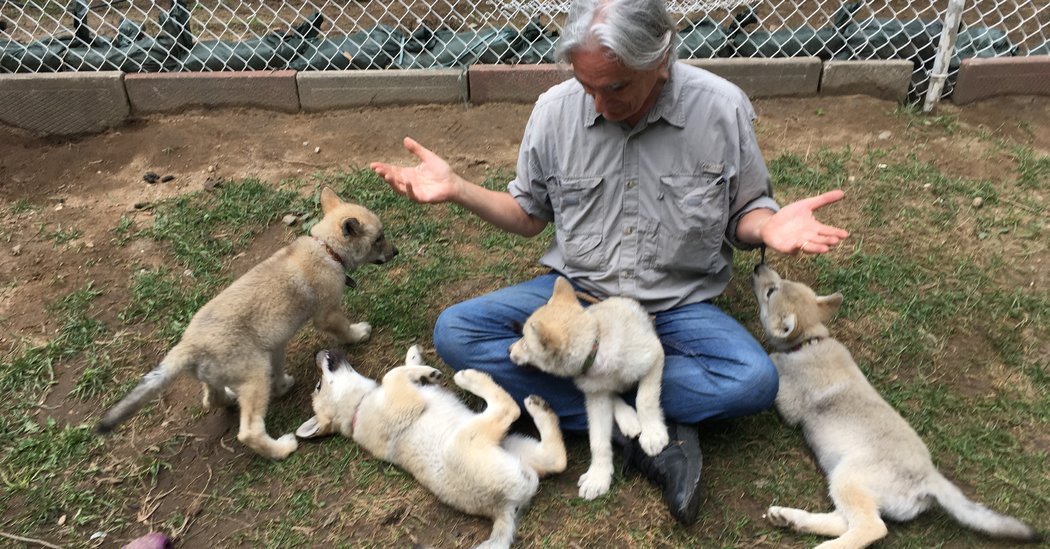James Gorman, a science writer at The Times who often covers the animal world, recently came to Quebec to look at what separates wolves from dogs. Along with gaining a better understanding of the topic, Mr. Gorman developed a moral quandary, as he explains:
Holding a wolf pup makes rational thinking go out the window.
After a year of talking to an evolutionary biologist about her plan to study the development of wolf pups as a way to understand how domestic dogs evolved, I ended up making two visits to Nicolet, Quebec, last spring and summer to spend time with a brood.
One result was a story about differences in development between two animals that are so close many researchers put them in the same species, canis lupus.
The location was Zoo Académie, a combination zoo and school for animal trainers owned and run by Jacinthe Bouchard, who has trained animals all over the world — wolves, tigers, elephants. Her strangest experience? “I trained a bat,” she said. It wasn’t easy, but, Ms. Bouchard insisted, “you can train anything that has a brain.” After a pause, she added, “So forget about teenagers. “
She bred her two female gray wolves this year, and they produced six pups between them. Quebec has about 7,000 of the animals. They can be hunted and are only protected in certain small areas. The Algonquin or Eastern wolf is protected. Over all, Canada’s wolf population of more than 50,000 is healthy. It has more than any country other than Russia. The United States has fewer than 6,000 wolves in the lower 48 states and perhaps as many as 11,000 in Alaska.
I first visited the wolves at Zoo Académie when they were 3 weeks old. They were babies then, still mostly blind and deaf and dependent entirely on scent. Holding and feeding them with a bottle had the same appeal as holding or feeding any baby mammal. It seems to trigger a parental longing to cuddle and nurture, and a tolerance for being peed on. They’re babies! They can’t help it.
I returned when the pups were 8 weeks old. They were still incontinent, but then they were really straddling the wolf-dog line. They were fuzzy, but fierce, already more independent than dog puppies their age. I could see the adult wolf coming, and it gave me the sense of being in touch with the wild, something I reveled in.
Only when I wasn’t with the wolves did I think about their future, which was to be captives. Ms. Bouchard treats her wolves as well as anyone can, and they have never known the wild, so they don’t know what they are missing. But they are still wolves and as Doug Smith, the scientist who led the reintroduction of wolves to Yellowstone National Park in the United States, said to me, wolves have three essential parts to their lives in the wild: they are deeply social and need other wolves, they roam large distances and they kill.
In captivity they can have a social life. But they will never roam and kill.
On the other hand they may inspire humans to care more about wolves. Seeing or touching an animal like a wolf in a zoo can be exhilarating. Of course, seeing a lone animal, or one pacing in a small enclosure, can be unspeakably sad.
I don’t have a fully worked-out moral position on zoos and animal experiments, partly because my job as a reporter trying to be fair is easier if I see the value in many points of view, and partly because my job is the perfect excuse for not coming to a conclusion.
But I have to say that those are afterthoughts that don’t really occupy the mind in the middle of spending time with the wolves themselves.
I didn’t come up with a conclusion after reporting this story. But I did gain a new sense of how profound the human longing for contact with other species can be. It’s not fundamentally rational. And I wonder if the desire to preserve and save the wild comes from contact with it. Can reason lead people to passion? The answer is, fortunately, beyond my job description.
I checked in with Ms. Bouchard this week for an update. She said the pups, at 5 months, now weigh 85 pounds. They are at a dangerous stage for handlers, because they are still puppies, wanting to bite and tussle as part of play, but with adult jaws and strength. They have “T. rex teeth,” she said.
Two of the pups went to BioParc in the Gaspé Peninsula and the other four are with their parents at Zoo Académie. I’m planning to visit them again, but I think next time I’ll just be watching, not cuddling
Canadians knew that time was running short for Gord Downie, the singer-songwriter and member of the Tragically Hip. But when news alerts and social media posts this week announced that the man whose lyrics gave voice to Canada had died of brain cancer, it seemed slightly unreal.
“The place of honor that Mr. Downie occupies in Canada’s national imagination has no parallel in the United States,” Simon Vozick-Levinson wrote in an article about the recording of Mr. Downie’s final album. “Imagine Bruce Springsteen, Bob Dylan and Michael Stipe combined into one sensitive, oblique poet-philosopher, and you’re getting close.”
Trade relations between Canada and the United States continued downward again this week on a variety of fronts.
The most sensitive of the trade spats, a preliminary tariff from the Trump administration that quadruples the prices of Bombardier’s new C Series airliner in the United States, took an unexpected turn this week. After spending more than $5 billion to create the airliner, the Montreal-based Bombardier sold just over 50 percent of it to Europe’s Airbus. Underscoring Bombardier’s desire to save the project, Airbus will not pay a penny or take on any of the project’s debt. The move will, however, mean that the plane can dodge the new American tariff by shifting some of its production from Canada to an Airbus assembly line in Alabama.
By IAN AUSTEN
https://www.nytimes.com/2017/10/20/world/canada/canada-letter-gord-downie-last-album-wolves-nafta.html
Source link

